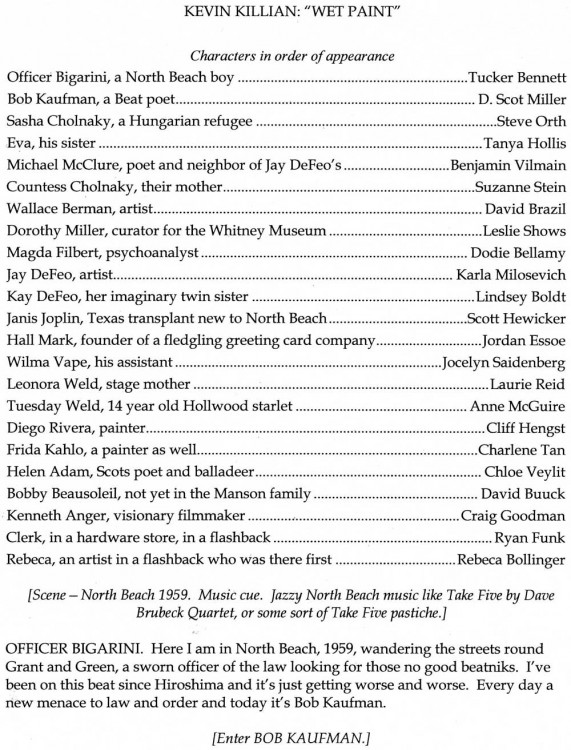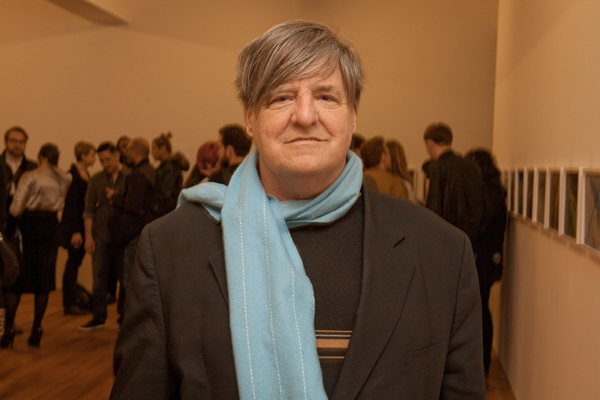Kevin Killian's Wet Paint

Left to right: Poet David Brazil as Wallace Berman and artist Scott Hewicker as Janis Joplin (with artist Karla Milosevich as Jay DeFeo, in front of a projection of The Rose.
We had such a tremendously fun time last week before, during, and after the Poets’ Theater performance of Kevin Killian‘s Wet Paint, I thought, Why not share THE SCRIPT with you all? and Kevin graciously agreed. Download it here.
From the evening’s program:
Wet Paint was commissioned by Bill Berkson at the San Francisco Art Institute, and premiered there October 10, 1996, in conjunction with Beat Culture and the New America, organized by Lisa Phillips for the Whitney Museum in New York, which opened in San Francisco at the de Young right around the same time. It was in this show that Jay DeFeo’s restored masterpiece The Rose was first displayed. Our play, revived here for the first time at SFMOMA’s Wattis Theater, tells the story of Jay DeFeo in decidedly non-hagiographic terms, inspired by Rebecca Solnit’s take on DeFeo in her pioneering book Secret Exhibition: Six California Artists of the Cold War Era. She was beautiful, talented, loved by all who knew her, the hippest chick in North Beach, but then why was Jay taking so long finishing one simple picture of one white rose, contracted as the image on a Hallmark card and seriously overdue as our play begins? Maybe it has something to do with her twin sister, Kay, whom nobody but Jay can see but who works on the painting at night when Jay is asleep, adding pounds more paint and making it harder and harder to see out the window in her Fillmore Street apartment.
In Wet Paint we see one woman’s struggle against the larger context of San Francisco’s bohemian underground, its prime movers (Kenneth Anger, Bruce Conner, Wallace Berman), and its occasional visitors (Frida and Diego, Dorothy Miller, a young Janis Joplin). Even Hollywood calls, as starlet Tuesday Weld arrives with her mother to study up for a beatnik movie she plans to make at Universal. San Francisco Poets’ Theater presents Wet Paint with a cast made up not of trained actors but of artists, poets, filmmakers, musicians, critics, and just general fans of Jay DeFeo. Despite its absurd touches, Wet Paint succeeds where a more cogent play might fail; it’s an ultimately touching salute to a great painter, by succeeding generations of present-day Bay Area artists.
—Kevin Killian
In his introduction, Frank Smigiel said he’d wanted to see one of Kevin’s plays produced on the Wattis stage ever since his first encounter with this unusual “indigenous” form of theater, shortly after arriving in San Francisco from New York six years ago. As a bit of prep for any audience member still unfamiliar with “the form,” Frank also read some excerpts from David Buuck‘s “Some Remarks on Poets’ Theater:”
PT performances are not plays.
At the same time, neither is PT merely skits or sketches. PT is a scripted event. That is, PT is written solely to occasion the getting together of the cast and the audience.
PT only occurs during the performance of the piece in front of others (and, often, at the bar afterwards).
No budget. Props and costumes should be homemade and/or cobbled together from what folks have at home.
Anti-illusionism. Props are only ever props, not the things they are meant to represent. “Actors” are not their roles, but just people (or, if you can’t get any people, poets).
Rigorous amateurism. Under-rehearsedness. Minimal stage directions. Serious silliness. Counter-professionalism. Backstage open bar. Improvisation, ad-libs, unscripted laughter, mistakes and missed cues; in short, spontaneous life-art happening between the line readings.
Even if lines are memorized, it’s still a staged reading.
No real actors. If a “real” actor appears in PT, it tends to make the audience blush on the actor’s behalf. There shouldn’t be trying, but being there doing it. Non-actors shouldn’t be expected to play their role, but to play themselves performing their role.
For every performer, at least one friend in the audience.
PT tends to have a lot of in-jokes, and tends, for better or worse, to be oriented toward the coterie. Jokes in PT are funny mostly because the audience is laughing together. This is how coteries get to know themselves.
The broader the code, the wider the coterie.
The best poets’ theater would be everyday life, with each person playing themselves. Total coterie, with everyone in on the jokes. In short, spontaneous life-art happening between the players.

Left to right: David Brazil as Wallace Berman; Scott Hewicker as Janis Joplin; Lindsey Boldt as evil imaginary twin of Jay DeFeo, Kay; Benjamin Vilmain as Michael McClure; Dodie Bellamy as Magda Filbert; Cliff Hengst as Diego Rivera; in the background a projection of The Rose.

Left to right: Painter Leslie Shows as legendary Whitney curator Dorothy Miller; artist Cliff Hengst as legendary womanizing mural painter Diego Rivera; artist Karla Milosevich as Jay DeFeo

Writer Dodie Bellamy as Magda Filbert, psychoanalyst to Jay DeFeo; Karla Milosevich as Jay DeFeo, discussing the difficulties of being a woman artist in male-dominated 1950s North Beach, San Francisco

Left to right: Rebeca Bollinger as Rebeca Bollinger, real artist; Ryan Funk as the paint store clerk who busts Jay DeFeo shoplifting paint; Karla Milosevich as Jay DeFeo, and Lindsey Boldt as Jay’s imaginary twin sister Kay; Steve Orth as sweet Sasha, innocent Hungarian refugee; Craig Goodman as Kenneth Anger, directing the flashback; Benjamin Vilmain as beat poet Michael McClure

